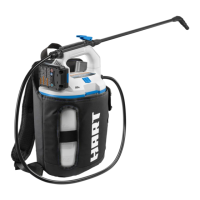3 – English
DANGER:
Risk of fire or explosion. Do not spray flammable liq-
uidssuchasgasoline.Lookforthissymbolreference
onthecontainer.
WARNING:
Some spray created from products used with the
sprayer contains chemicals known to the State of
California to cause cancer, birth defect of other repro-
ductiveharm.Someexamplesofthesechemicalsare:
• compoundsinfertilizers;
• compounds in insecticides, herbicides, and
pesticides;
• arsenic and chromium from chemically treated
lumber.
Followdirectionsoncontainersofallsuchproducts.
To reduce your exposure to these chemicals, wear
approvedsafetyequipmentsuchasfacemasksthat
arespeciallydesignedtofilteroutsprays,gloves,and
otherappropriateprotectiveequipment.
Before using any pesticide or other spray materials
in this sprayer, read the label on its original container
thoroughly and follow its directions. Some spray mate-
rials are dangerous and should not be used in this sprayer,
as they can damage the sprayer and cause serious bodily
injuryorpropertydamage.
Electric shock hazard. Never spray toward electrical
outlets.
Do not use commercial grade chemicals or chemicals
for commercial or industrial purposes. Use only con-
sumergradewater-basedlawnandgardenchemicals.
Do not pour hot or boiling liquids into the tank. These
canweakenordamagethehoseortank.
Spray area must be well ventilated.
Avoid spraying on windy days. Spray can be acciden-
tally blown onto plants or objects that should not be
sprayed.
Store the sprayer in a secure, well-ventilated indoor
space with the fluid tank empty.
Do not use caustic (alkali) self-heating or corrosive
(acid) liquids in this sprayer. These can corrode metal
partsorweakenthetankandhose.
Know the contents of the chemical being sprayed.
Read all Material Safety Data Sheets (MSDS) and
container labels provided with the chemical. Follow
thechemicalmanufacturer’ssafetyinstructions.
Do not smoke while using the sprayer, or spray where
sparkorflameispresent.
Risk of injection.Donotdischargedirectlyagainstskin.
To reduce the risk of electric shock, do not put the
sprayer into water or other liquid. Do not place or store
thesprayerwhereitcanfallorbepulledintoatuborsink.
Maintain this product. Thoroughly inspect both the
inside and outside of the sprayer and examine the
components before each use. Check for cracked and
deteriorated hoses, leaks, clogged nozzles, and miss-
ing or damaged parts. If damaged, have the product
repaired before use. Many accidents are caused by
poorlymaintainedproducts.
Disconnect the battery from the unit before draining,
cleaning, or storing the sprayer. Suchpreventivesafety
measuresreducetheriskofaccidentalstarting.
Always wear eye protection with side shields or
goggles marked to comply with ANSI Z87.1. Failure to
do so could result in fluids entering your eyes resulting in
possibleseriousinjury.
Protect your lungs. Wear a face or dust mask when
using the sprayer. Following this rule will reduce the risk
ofseriouspersonalinjury.
Battery tools do not have to be plugged into an elec-
trical outlet; therefore, they are always in operating
condition. Be aware of possible hazards when not
using your battery tool or when changing accessories.
Remove battery pack when tool is not in use. Follow-
ing this rule will reduce the risk of electric shock, fire, or
seriouspersonalinjury.
Do not place battery tools or their batteries near fire
or heat. This will reduce the risk of explosion and pos-
siblyinjury.
Do not crush, drop or damage battery pack. Do not
use a battery pack or charger that has been dropped
or received a sharp blow. Adamagedbatteryissubject
toexplosion.Properlydisposeofadroppedordamaged
batteryimmediately.
Batteries can explode in the presence of a source
of ignition, such as a pilot light. To reduce the risk of
seriouspersonalinjury,neveruseanycordlessproduct
inthepresenceofopenflame.Anexplodedbatterycan
propeldebrisandchemicals.Ifexposed,flushwithwater
immediately.
Never use water or any liquids to clean or rinse off
the outside of your product and do not expose the
IMPORTANT SAFETY INSTRUCTIONS
SPECIFIC SAFETY RULES

